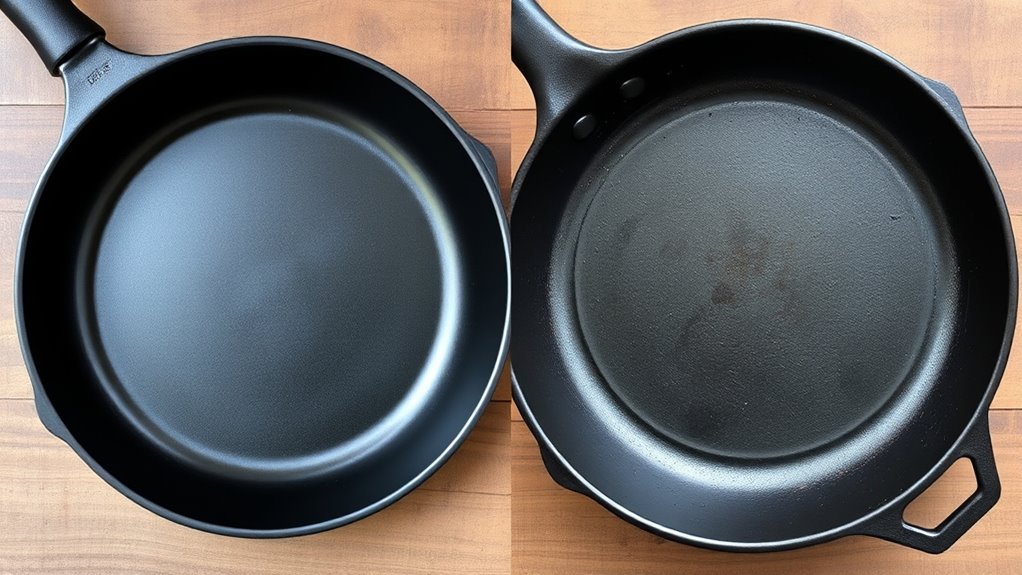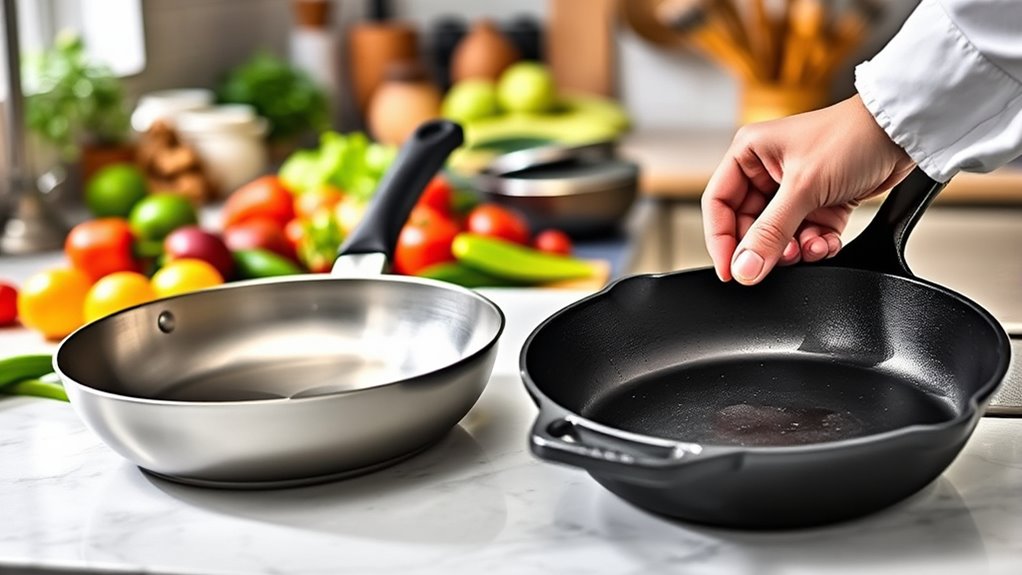If you’re choosing between non-stick and cast iron cookware, consider your cooking style and priorities. Non-stick pans are great for easy food release and quick cleanup, but they may need replacing sooner. Cast iron offers durability, excellent heat retention, and can last a lifetime if cared for properly. Both types have health and safety considerations, too. To find out which option suits your needs best, there’s more to explore below.
Key Takeaways
- Non-stick cookware offers easy food release and quick cleaning, ideal for delicate items, while cast iron excels in heat retention and searing.
- Cast iron is highly durable and long-lasting with proper care, whereas non-stick pans may need replacement sooner due to coating wear.
- Non-stick coatings can release fumes if overheated and may contain chemicals, while cast iron leaches iron but has no chemical coatings.
- Cast iron requires regular seasoning and specific maintenance, whereas non-stick cookware is simpler to clean and maintain.
- Long-term investment favors cast iron for durability, despite higher initial costs, offering better value over time.
Material Composition and Construction

Non-stick cookware typically features a base made from aluminum or stainless steel coated with a non-reactive, often synthetic, non-stick layer such as polytetrafluoroethylene (PTFE). This construction influences coating consistency, ensuring an even, smooth surface that prevents food from sticking. Aluminum provides excellent thermal conductivity, quickly distributing heat across the surface, making it easier to control cooking temperatures. Stainless steel, while slightly less conductive, offers durability and resistance to corrosion. The non-stick layer is applied uniformly during manufacturing, which enhances coating consistency and longevity. Proper maintenance practices can extend the lifespan of non-stick cookware and preserve its non-stick properties. Additionally, understanding the impact of material composition helps you select cookware that balances performance, durability, and ease of use. Recognizing the construction techniques used in manufacturing can help you choose cookware that balances performance, durability, and ease of use.
Cooking Performance and Versatility

When it comes to cooking performance, the type of cookware you choose can considerably impact your results. Non-stick cookware offers easy food release, thanks to its non-stick coating, making it ideal for delicate items like eggs or pancakes. Cast iron excels in heat retention, providing even cooking and great searing capabilities. Additionally, understanding different divorce processes can help you navigate legal challenges effectively. For example, cast iron’s ability to develop a natural non-stick surface over time through seasoning enhances its cooking performance, making it a versatile option for many cooks. Incorporating proper maintenance techniques extends the lifespan and performance of your cookware.
Care, Maintenance, and Durability

Caring for your cookware properly guarantees it lasts longer and performs better over time. For non-stick pans, use gentle cleaning methods like warm water and a soft sponge to avoid scratching the coating. Avoid abrasive scrubbers or harsh detergents. Cast iron requires a different approach: clean with minimal soap or just hot water, then dry thoroughly to prevent rust. Season your cast iron regularly to maintain its non-stick surface. Storage tips also matter—store cookware in a dry place, and for cast iron, keep it seasoned and avoid stacking heavy items directly on top. Proper care and maintenance enhances durability, ensuring your cookware remains functional and in top shape for years. Additionally, practicing mindful storage strategies can prevent damage and prolong the lifespan of your cookware. Maintaining the correct cleaning techniques for each material helps preserve their unique properties and performance. Being aware of corrosion prevention methods can further extend the life of your cast iron cookware. With consistent maintenance, both non-stick and cast iron pans can serve you well through countless meals.
Health and Safety Considerations

Proper maintenance not only extends the lifespan of your cookware but also impacts your health and safety in the kitchen. When choosing non-stick or cast iron, chemical safety is vital. Non-stick coatings often contain chemicals like PTFE, which can release fumes if overheated, posing health risks. Cast iron, on the other hand, doesn’t have chemical coatings but can leach iron into food, which may be a concern for some. Additionally, allergen concerns play a role; cast iron is naturally hypoallergenic, while non-stick surfaces might harbor residues if not properly cleaned, potentially triggering allergies. Always follow manufacturer guidelines to prevent chemical exposure or allergen buildup. Proper safety measures ensure your cookware remains safe for everyday use, helping you cook healthier and avoid unnecessary health issues. Understanding heat pump technology can also help in making informed decisions about energy-efficient appliances at home. Being aware of chemical safety guidelines in cookware maintenance can further reduce potential health risks, especially when considering safe cleaning practices to prevent residue accumulation.
Cost and Long-Term Investment

Choosing between non-stick and cast iron cookware often comes down to cost and how much you’re willing to invest over time. A price comparison shows that non-stick pans are generally more affordable upfront, making them a budget-friendly option for many. However, they may need replacing sooner due to coating wear, increasing long-term costs. Cast iron cookware requires a higher initial investment but lasts decades if properly maintained, making it a smart long-term investment. While the initial price might be higher, you’ll save money over time because of its durability. If you’re looking for budget-friendly options, non-stick cookware is attractive initially, but if longevity and durability matter to you, cast iron provides better value in the long run.
Frequently Asked Questions
Which Cookware Is Better for Induction Stovetops?
When choosing cookware for induction stovetops, you need to consider induction compatibility and magnetic properties. Not all cookware works well; look for pots and pans with ferromagnetic material. Cast iron is an excellent choice because of its strong magnetic properties, ensuring efficient heat transfer. Non-stick options may also work if they contain a magnetic base. Ultimately, select cookware that’s specifically labeled for induction to ensure safe and effective cooking.
Can Non-Stick Coatings Withstand High-Temperature Cooking?
Ever wondered if your non-stick coating can handle high heat? While it’s convenient, durability concerns arise because most coatings aren’t designed for high-temperature cooking. The coating’s longevity diminishes quickly with frequent high heat, risking peeling or damage. For intense heat, you might want to think about alternatives like cast iron, which can withstand higher temperatures without compromising durability or safety. So, use non-stick cookware wisely to extend its lifespan.
Is Cast Iron Cookware Suitable for Oven Use?
Yes, cast iron cookware is suitable for oven use because it offers excellent oven safety and heat resistance. You can transfer it directly from stovetop to oven without worries about damage. Its ability to withstand high temperatures makes it ideal for baking, roasting, and searing. Just confirm the handle is oven-safe, and you’re good to go. Cast iron’s durability makes it a versatile choice for various oven cooking tasks.
How Do Non-Stick Pans Affect Food Flavor?
You might notice that non-stick pans can influence food flavor by preserving natural taste, thanks to their smooth coating. However, over time, the coating’s durability can decline, potentially affecting flavor and making food stick or taste different. This means that while non-stick pans are great for easy release and flavor preservation initially, their coating durability is essential to maintain consistent flavor and prevent unwanted tastes from lingering.
Are There Eco-Friendly Options for Both Types of Cookware?
Imagine cooking with a conscience—eco-friendly options shine like a beacon. For non-stick pans, seek out cookware made from eco-friendly materials like ceramic or recycled aluminum, crafted through sustainable production methods. Cast iron too can be green, especially when sourced from companies committed to sustainable practices. By choosing these options, you turn your kitchen into a sanctuary of mindful choices, blending performance with planet-friendly principles, one meal at a time.
Conclusion
Choosing between non-stick and cast iron cookware is like picking between a trusty sidekick and a rugged hero—you’ll want both for different battles in the kitchen. Non-stick offers effortless cooking, while cast iron delivers unmatched durability and flavor. So, which will you choose? Remember, the right cookware isn’t just about tools—it’s about transforming everyday meals into memorable moments. Your perfect kitchen partner awaits—ready to turn every dish into a masterpiece.









